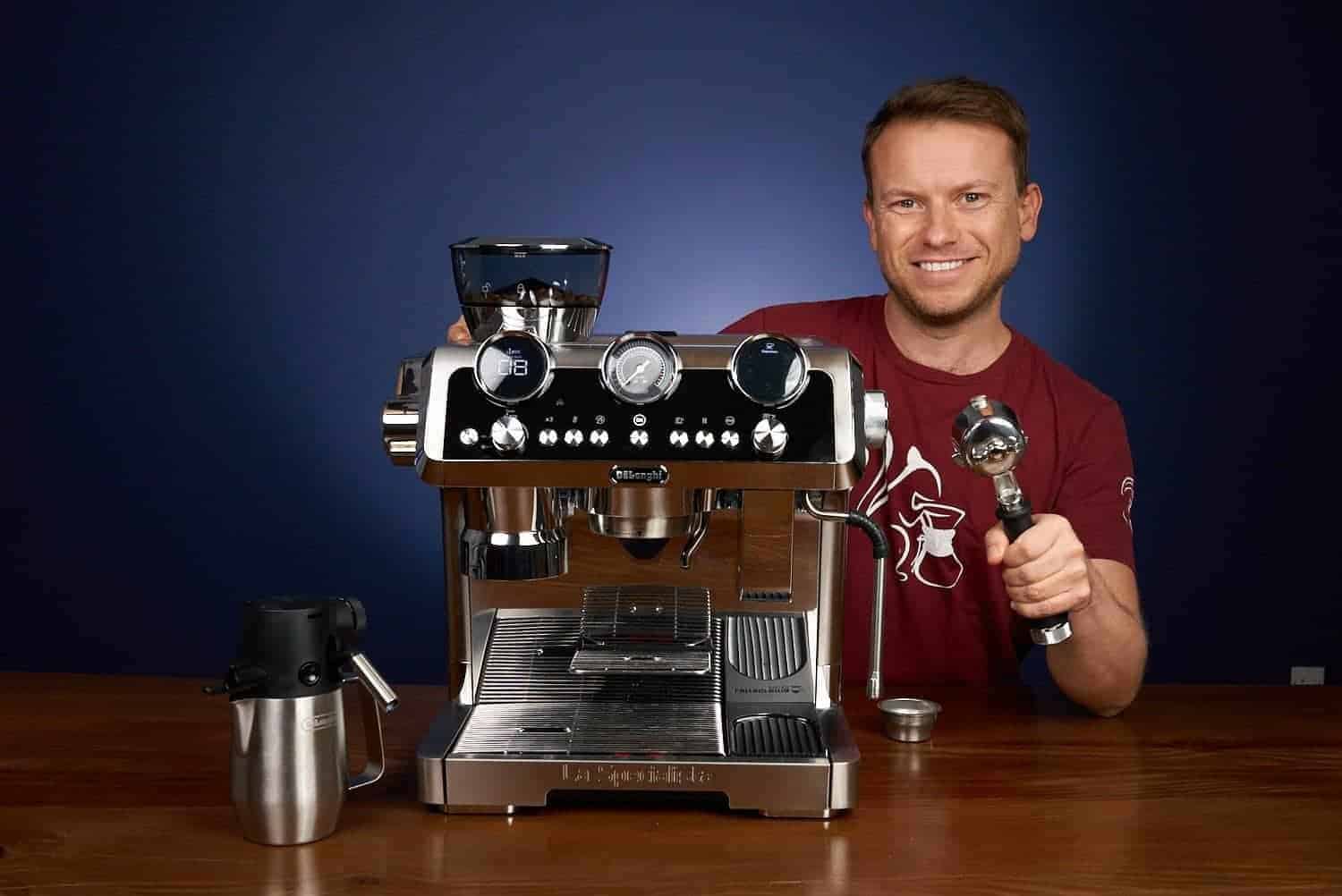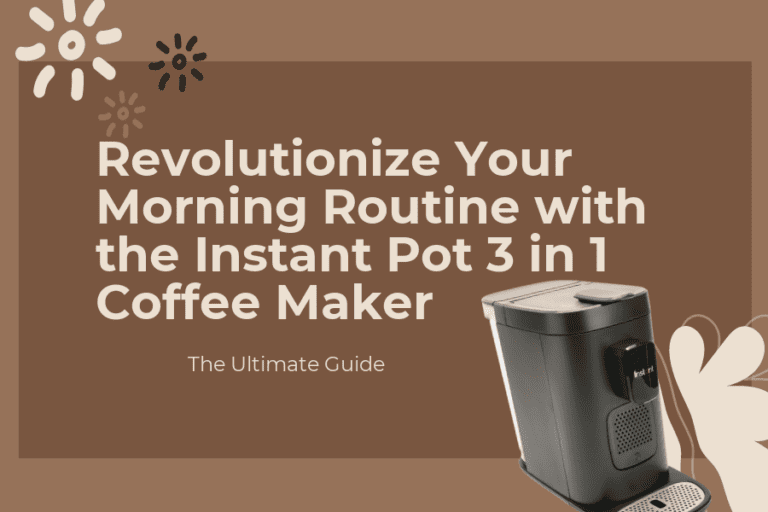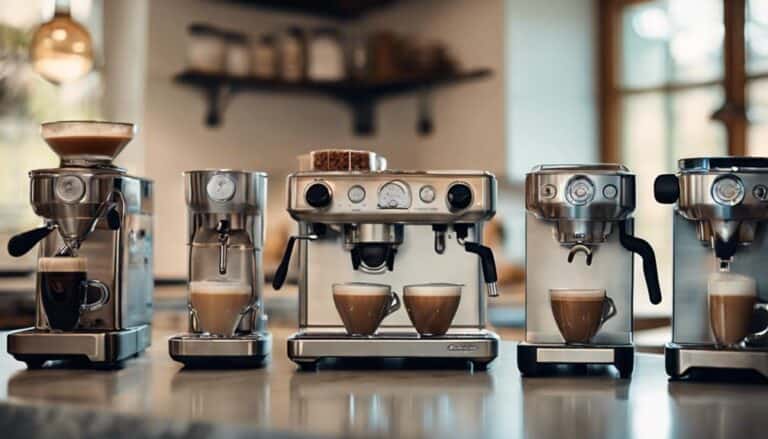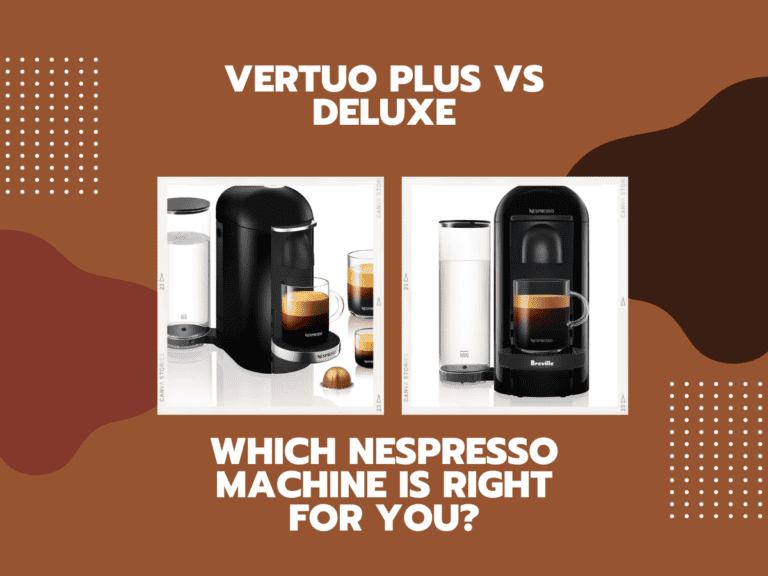Coffee Maker by Hand: Mastering the Art of Manual Brewing

The art of making coffee by hand has been revered by coffee connoisseurs for centuries. Handcrafted coffee allows the maker to have full control over the brewing process, ensuring that the delicate flavors and aromas of the coffee beans are preserved. Using a coffee maker by hand, we can appreciate the craftsmanship involved in creating the perfect cup of coffee while enjoying the meditative process of manual brewing.

As coffee enthusiasts, we know that the search for the ideal coffee maker is a personal journey. Each individual will have their unique preferences and requirements, ranging from design aesthetics to brewing techniques. Hand-operated coffee makers offer a variety of options, suitable for both beginners and seasoned baristas looking to explore new avenues in coffee making.
Key Takeaways
- Handcrafted coffee provides full control over the brewing process, preserving delicate flavors and aromas.
- Selecting the right hand-operated coffee maker is a personal journey based on individual preferences and brewing techniques.
- Portable coffee makers offer a convenient option for coffee lovers to enjoy their favorite brews on-the-go.
The Essence of Handcrafted Coffee

Understanding Coffee Maker Basics
When it comes to brewing coffee, many enthusiasts embrace the hands-on approach to create the perfect cup. Handcrafted coffee allows us to pay close attention to the details, making every cup a rewarding experience. With various methods like espresso, pour-over, and French press, it’s essential to understand the basics of each technique to appreciate the craftsmanship involved.
Espresso is a popular method, commonly used as the base for lattes and cappuccinos. The process involves forcing hot water under high pressure through finely ground coffee beans. To achieve a delicious and balanced cup of espresso, we need to control variables such as temperature, pressure, and grind size. In general, espresso machines can be manual, semi-automatic, or fully-automatic. Manual espresso machines like the La Pavoni give us full control over each step of the process, allowing us to achieve a superior taste.
Comparing Espresso, Pour-Over, and French Press
Espresso:
- Pressure brewing
- Produces a rich, thick coffee, usually used for lattes and cappuccinos
- Requires more skill and expensive equipment
Pour-Over:
- Gravity driven
- Produces a clear, clean taste by allowing water to pass through a coffee filter
- Allows control over water temperature and brewing time
- Pour-over tools like the Chemex brewer
French Press:
- Immersion brewing
- Produces a full-bodied, bold flavor by steeping coffee grounds in hot water
- Requires coarser grind size to avoid over-extraction
- Pressing the plunger separates the coffee grounds from the liquid
When choosing a method to create handcrafted coffee, consider the desired flavor and mouthfeel. Espresso produces a more intense flavor, suitable for milk-based drinks like lattes and cappuccinos. The pour-over method highlights the coffee’s unique characteristics, creating a bright and clean taste. The French press offers a bolder and more robust flavor, with the option to control the strength and brewing time.
Embracing handcrafted coffee means understanding each brewing technique’s core elements and adjusting variables to suit your preferences. Through practice and experimentation, we can create our ideal cup of coffee, showcasing our dedication to the art of coffee-making.
Selecting the Right Coffee Maker by Hand
Evaluating Manual Espresso Machines
When it comes to manual espresso machines, there are several factors to consider. First, think about the type of coffee grinder you’ll be using. A high-quality, burr grinder can ensure a consistent grind and ultimately better extraction. We recommend researching various grinders to find one that complements your espresso machine.
Next, consider the build quality and materials used in the espresso machine. Many enthusiasts prefer machines made from durable materials like stainless steel or brass. These machines are often more expensive upfront, but they tend to last longer.
Finally, look for features that match your level of skill and experience. For beginners, a machine with a pressurized portafilter might be more forgiving, while experienced users may prefer one with a non-pressurized design.
The Art of Choosing a Pour-Over Brewer
There are several factors to account for when selecting a pour-over brewer. Here are a few points to keep in mind:
- Materials: Both ceramic and stainless steel are popular choices, each with its own pros and cons. Ceramic tends to maintain a more consistent temperature throughout the brewing process, while stainless steel is more durable and easier to clean.
- Filter type: Paper filters offer the cleanest cup of coffee, while metal filters allow more oils and sediments to pass through, adding body to the brew.
- Size: Pour-over brewers come in various sizes, from single-cup options like the AeroPress to larger devices, capable of brewing multiple cups at once.
Why French Press Remains a Classic Choice
The French Press is a popular choice for coffee enthusiasts because of its simplicity and consistent results. Here are some reasons why it remains a classic choice:
- Flavor: The metal filter in a French Press allows more oils and soluble flavors to pass through, creating a full-bodied, rich brew.
- Ease of use: French Presses are simple to operate, making them a great option for beginners and experienced coffee drinkers alike.
- Versatility: French Presses can also be used to make cold brew coffee, or even to steep loose-leaf tea.
When selecting a French Press, consider factors such as materials, plunger design, and capacity. Choosing the right French Press is only one part of the equation; ensure you use a suitable coffee grinder for achieving a consistent, coarse grind. And, although not as prominent as with other methods, you could still include devices like the Moka Pot or AeroPress as alternatives to a fully manual process.
Grinding for the Perfect Cup
Coffee Grinder Types and Benefits
When it comes to brewing coffee, a crucial step is choosing the right coffee grinder and understanding its benefits. There are two main types of coffee grinders on the market: burr grinders and blade grinders. Burr grinders, which include manual grinders, electric flat burr grinders, and electric conical burr grinders, use two revolving surfaces that grind the coffee beans consistently and evenly, providing a better extraction of flavors and aromas. Blade grinders, on the other hand, tend to chop the beans unevenly, which can result in an inconsistent brew.
We recommend investing in a quality burr grinder for a more consistent and flavorful coffee experience. Burr grinders allow you to control the grind size, which is essential for different brewing methods, as we’ll discuss below.
Grind Settings for Different Brewing Methods
Different brewing methods require distinct grind sizes to extract the best flavors and aromas from the coffee beans. Here, we will outline some recommended grind settings for three popular brewing methods: espresso, drip coffee, and cold-brew coffee.
- Espresso: For this method, you’ll need a fine grind size, similar to the texture of granulated sugar, or even finer (think: powdered sugar). This allows for optimal extraction during the short brewing time. Remember to adjust the grind size depending on the type of espresso machine you’re using, as well as the specific beans and roast level.
- Drip Coffee: For most drip coffee makers, a medium grind size, comparable to the texture of coarse sand, is ideal. This allows for proper extraction and maintains a good balance between extraction time and water flow. A 1:15 or 1:16 water-to-coffee ratio is typically recommended for drip coffee, while personal preference and bean type may call for adjustments.
- Cold-Brew Coffee Maker: Preparing cold-brew coffee requires a coarse grind size, similar to sea salt. This is because cold-brew coffee involves a longer brewing time (generally 12-24 hours) and slower extraction process, which results in a smooth, less acidic taste profile.
With the right coffee grinder and appropriate grind settings, you can elevate your coffee experience and savor a perfect cup every time. Paying close attention to these factors will ensure the fullest flavors and aromas in each brewing method.
Coffee Making Techniques
Mastering the Moka Pot
The Moka Pot is an excellent brewing method for those looking to create a rich, espresso-like coffee experience at home. To effectively use a Moka Pot, follow these steps:
- Fill the bottom chamber with water, up to the water line or pressure valve.
- Insert the coffee funnel and fill it with finely ground coffee, without compressing it.
- Assemble the pot and place it on a medium heat source.
- Once the coffee starts to flow into the top chamber, lower the heat.
- When the brewing is completed, remove the pot from the heat source and enjoy!
Tip: For an even richer taste, use a dark Italian roast.
Pour-Over Precision
Pour-over coffee is a delightfully simple method that allows for a clean and controlled coffee extraction. Here’s how to achieve pour-over precision:
- Preheat the filter and brewer by pouring hot water over them.
- Discard the preheat water, and add medium-fine coffee grounds to the filter (roughly 2 tbsp per 8 oz of water).
- Begin the initial pour, starting from the center and circling outward. This phase is called the “bloom” and should saturate the coffee grounds without any water exiting the filter.
- Wait for 30-45 seconds, then continue pouring in a slow circular motion, avoiding the filter edges.
- Complete the pouring process and let the coffee drain into your server or cup.
French Press Fundamentals
The French Press is a classic brewing method known for its full-bodied and rich flavor. Follow these steps to perfect your French Press technique:
- Coarsely grind your coffee beans (roughly 1:15 ratio of coffee to water).
- Add the coffee grounds to the French Press and preheat with hot water for about 30 seconds.
- Pour in hot water (around 200°F) to the desired level, and gently stir the mixture.
- Place the lid on the French Press, ensuring the plunger is pulled all the way up.
- Steep for 4 minutes, and then slowly press down the plunger.
- Pour and enjoy your delicious French Press coffee.
Aeropress Adventures
The Aeropress is a versatile and portable brewing method that can provide a smooth, low-acidity coffee with simple steps:
- Assemble the Aeropress by attaching the filter cap to the brewing chamber.
- Add a paper filter to the cap and rinse it with hot water to remove any papery flavor.
- Add medium-fine coffee grounds to the brewing chamber (about 2-3 Aeropress scoops).
- Pour in hot water (around 200°F) to saturate the coffee grounds, and stir for about 10 seconds.
- Attach the plunger to the brewing chamber and let the coffee steep for a minute.
- Press down the plunger steadily in about 30 seconds.
- Dilute the concentrated coffee with hot water if desired, and enjoy your Aeropress brew.
Accessorizing Your Coffee Experience

In this section, we will explore essential coffee accessories and gadgets that can enhance your coffee-making experience.
Essential Coffee Accessories
To elevate your coffee-making process, it’s crucial to invest in a few key accessories. The foundation for a great cup of coffee starts with freshly ground beans. A good quality coffee grinder allows you to control the consistency of your grind, which greatly impacts the flavor of your brew.
Another essential accessory is a pour-over coffee maker. A reusable stainless steel filter contributes to a smoother and richer taste, all while being more environmentally friendly than traditional paper filters.
If you prefer a hot cup of coffee that stays warm for an extended period, consider opting for a thermal carafe. On the other hand, a glass carafe provides the benefit of visualizing the coffee-making process and ensuring that your brew is neither too weak nor too strong.
To create a luxurious and indulgent texture, investing in a frother is essential. A manual frother uses a plunger system to create a creamy foam, perfect for topping off your coffee.
Here’s a summary of the essential coffee accessories:
- Good quality coffee grinder
- Pour-over coffee maker
- Reusable stainless steel filter
- Thermal carafe or glass carafe
- Manual frother
Customizing with Coffee Gadgets
In addition to the essential accessories, there are also numerous coffee gadgets available that can further customize and optimize your coffee-making experience. For instance, a digital scale can help you measure the precise amount of coffee beans or grounds, ensuring consistency in every cup you brew.
Another useful gadget is a gooseneck kettle with temperature control. This enables you to heat water to the exact temperature desired for optimal brewing, enhancing the flavor of your coffee.
We hope that this brief guide to essential coffee accessories and gadgets has provided inspiration and guidance for customizing your coffee experience. Happy brewing!
Portable Coffee Makers for Every Occasion
There are many portable coffee makers on the market that provide convenience and good quality coffee for various occasions. Whether you’re traveling, camping, or backpacking, having a handy and compact coffee maker can make your experience more enjoyable. In this section, we will discuss portable coffee makers, focusing on travel and outdoor solutions.
Coffee on the Go: Travel and Outdoor Solutions
AeroPress Go: A popular portable coffee maker, the AeroPress Go is compact and lightweight, making it perfect for travel and outdoor enthusiasts. It is easy to clean and produces a consistently smooth and flavorful cup in just a few minutes.
Cafflano Klassic: Combining a grinder, drip kettle, and pour-over brewer in one device, the Cafflano Klassic is an all-in-one solution for those who want fresh coffee on the go. This innovative tool is highly portable and makes it easy to enjoy quality coffee anywhere.
Pipamoka: Built specifically for outdoor lovers, the Pipamoka uses a vacuum pressure brewing method that ensures a quick brewing time and rich taste. Its durable design, compact size, and integrated travel mug make it an excellent choice for camping and backpacking trips.
Wacaco Nanopresso: With its small form factor and impressive performance, the Nanopresso is a powerful option for espresso enthusiasts on the move. It requires no electricity and is capable of reaching an impressive 18 bars of pressure for a rich and creamy espresso shot.
Picopresso: Wacaco’s latest addition, the Picopresso, boasts a sleeker design and 20 bars of pressure for a more authentic espresso experience. It is equally portable as its predecessor, the Nanopresso, and offers a reliable and consistent brewing method for those who want excellent coffee on their journeys.
To sum up, we have discussed various portable coffee makers suitable for different occasions and preferences. Whether you’re a casual coffee drinker or a serious espresso aficionado, we hope these options help you find the perfect companion on your adventures.
The Impact of Coffee Makers on Lifestyle
Coffee Makers and the Modern Kitchen
In recent years, coffee makers have become an essential part of the modern kitchen. They provide convenience and allow us to easily create various types of coffee beverages at home. Drip coffee makers and single-serve coffee machines are among the most popular choices for home use. These appliances can save both time and money by making it easier to enjoy a quality cup of coffee without the need to visit a café.
As coffee aficionados, we appreciate how these machines have changed our morning routines and helped us create our own at-home coffee stations. It’s worth mentioning the importance of choosing eco-friendly coffee alternatives and considering the environmental impact of coffee maker usage.
Coffee Makers for Office, School, and Travel
Office spaces and schools have also been positively impacted by the inclusion of coffee makers. Workers and students alike appreciate the convenience of having a coffee station nearby, which provides an opportunity for socialization and interaction while enjoying a cup of joe. Ensuring that these locations have coffee makers can boost productivity and enhance the overall atmosphere of the space.
In addition to stationary locations, the popularity of portable coffee makers has risen for travel enthusiasts. These devices allow travelers to enjoy a quality cup of coffee anywhere they have access to hot water. By being able to take the familiar comfort of a coffee maker on the go, people can benefit from a consistent caffeine boost regardless of their location.
Integrating Coffee Makers with Tech and Gaming
The integration of coffee makers with technology and gaming has opened up new possibilities for customization and ease of use. Some machines now boast features such as touchscreens, smart home compatibility, and even built-in grinders for added convenience.
Gaming enthusiasts know the importance of maintaining focus and alertness during long sessions, and having a coffee maker close by can provide a much-needed caffeine boost. Some gaming setups now incorporate coffee maker stations to save space and keep players fueled up.
In conclusion, coffee makers have impacted our lives in various aspects, ranging from home kitchens to workplaces and travel. By integrating technology and understanding the potential environmental impacts, we are able to make informed decisions and continue to enjoy coffee as part of our everyday lifestyles.
Buying Guide: Best Overall Coffee Makers by Hand
Top-Rated Manual Espresso Machines
Manual espresso machines allow us to have full control over the brewing process, ensuring a perfect cup of espresso every time. When looking for the best overall manual espresso machines, here are some factors to consider:
- Quality and materials: Opt for machines made with durable stainless steel or brass to ensure longevity.
- Pressure: Manual espresso machines should provide a consistent pressure of 9 bars or more to extract the rich flavors from high-quality beans.
Some of the highly recommended manual espresso machines include:
- Flair Espresso Maker: Known for its simplicity and precision, allowing us to customize every aspect of the brewing process.
- La Pavoni Europiccola: A classic Italian espresso machine with a unique lever design and a long-lasting stainless-steel build.
Best Pour-Over Coffee Makers
Pour-over coffee makes a delicious and smooth cup of coffee as it allows for even saturation of the grounds. Here are some key features to look for in the best pour-over coffee makers:
- Material: Ceramic, glass, or stainless steel are preferred materials as they don’t alter the taste of the coffee.
- Dripper design: Look for drippers with a flat bottom or a cone shape, allowing for even extraction of caffeine and flavor.
Our top picks for pour-over coffee makers are:
- Hario V60: A popular ceramic coffee dripper known for its precise extraction and temperature control.
- Chemex Classic Series: An elegant glass pour-over coffee maker that combines beautiful design with excellent functionality.
Leading French Press Makers
French press coffee makers are a classic and easy way to make great coffee at home. When searching for the best French press makers, consider the following:
- Materials: Stainless steel or glass French press makers are considered the best options due to their durability and taste preservation.
- Plunger design: Opt for a tight-sealing plunger to prevent coffee grounds from slipping into your cup.
Here are two of the leading French press makers:
- Bodum Chambord: A stylish and iconic glass French press with a stainless-steel plunger and frame.
- Espro P7: A double-walled stainless steel French press that keeps the coffee hot and offers a double micro-filter for a cleaner cup.
By choosing the right manual coffee maker and high-quality beans, we can elevate our caffeine experience to new heights. Happy brewing!
Maintaining Your Handcrafted Coffee Maker
Cleaning and Care
Regularly cleaning your handcrafted coffee maker will not only ensure its durability but also preserve its stylish and modern design. We recommend following these simple steps to maintain your coffee maker:
- Disassemble the components: Carefully remove any removable parts of your coffee maker to clean them thoroughly.
- Rinse with water: Gently rinse the parts with warm water to remove any lingering coffee grounds or residue.
- Cleaning solution: Prepare a cleaning solution using equal parts water and white vinegar. This natural cleaning solution helps break down leftover coffee oils and flush out built-up bacteria.
- Soak the components: Soak the removable parts, such as the water tank, carafe, or drip tray, in the cleaning solution for a few minutes. You can also use specialized cleaning agents like Cafiza for a more thorough cleaning.
- Scrub gently: Use a soft brush or sponge to scrub the soaked parts gently, removing any stains or residue.
- Rinse and reassemble: Rinse the components with clean water, and let them dry before reassembling your coffee maker.
When to Replace Coffee Maker Components
As with any appliance, there comes a time when certain components need to be replaced to maintain your handcrafted coffee maker’s performance and preserve its modern design. Here’s a brief rundown of when it might be time to replace specific parts:
- Filters: Replace them according to the manufacturer’s recommendation or when they start to show visible signs of wear. Regular paper filters can be switched out after each use, while metal and cloth ones should be replaced every few months.
- Carafe: A cracked, chipped, or stained carafe can affect the taste of your coffee and the overall attractiveness of your coffee maker. Replace it when you notice these signs or when it no longer maintains the desired temperature for your coffee.
- Water Reservoir: Over time, mineral deposits can accumulate in the water reservoir, affecting the water’s quality and the taste of your coffee. If descaling and regular cleaning do not improve the water’s quality, consider replacing the reservoir.
By following these guidelines, we can ensure our handcrafted coffee makers remain both functional and aesthetically pleasing for years to come.
Conclusion
When it comes to brewing coffee, the debate on whether to use a manual or a machine-made coffee maker will always exist. We appreciate handmade coffee for its authentic and rich flavors, as it allows us to have a more personal connection with our coffee. On the other hand, machine-made coffee can provide us with consistency, speed, and various presets for the best coffee experience.
In deciding which method to choose, consider your own preferences. If you enjoy the process of making coffee and value the intricate flavors, a manual brewing method, like a French press, would suit your taste. If convenience and speed are more important, consider a machine-made option, like an electric coffee maker or Keurig.
Manual brewing benefits:
- Richer and more authentic flavors
- Greater control over the brewing process
- Can be cheaper and more affordable
Machine-made brewing benefits:
- Quick and convenient
- Consistent results
- Comes with multiple presets for different coffee styles
If you’re still undecided, experimenting with both methods can be a great idea. Try making coffee with a manual method like pour-over or an AeroPress, and compare the results to coffee made with your favorite automatic coffee maker. You may find that different methods work better for different occasions or varying coffee bean types.
Ultimately, our coffee experience should reflect our personal preferences and lifestyle. As long as you enjoy your coffee, whether it’s handmade or machine-made, savor the moment and make the most of it.




